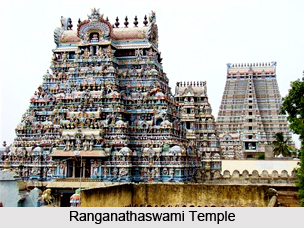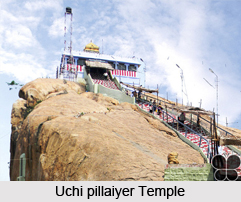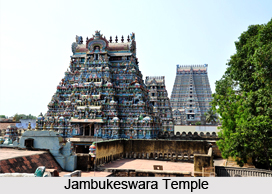 The monuments in Tiruchirapally are many in number but the chief attraction of the place has always been the Rock Fort. Tiruchirapally, popularly known as Trichy is situated along the banks of the Kaveri River. It has been named after the three headed monster Tirusura who was defeated by Lord Shiva and thus attained salvation. The city is centrally located in the state of Tamil Nadu and famous for its architecture and monuments. It was formerly pronounced as Trichinopoly under the British.
The monuments in Tiruchirapally are many in number but the chief attraction of the place has always been the Rock Fort. Tiruchirapally, popularly known as Trichy is situated along the banks of the Kaveri River. It has been named after the three headed monster Tirusura who was defeated by Lord Shiva and thus attained salvation. The city is centrally located in the state of Tamil Nadu and famous for its architecture and monuments. It was formerly pronounced as Trichinopoly under the British.
The history of the place has a long tradition of dynastic rule going back almost 2500 years. It was governed at different times by the Cholas, Pandyas, the Pallavas, and Nayakas and later the British. Originally a Chola citadel (1st century AD), it later fell to other south Indian dynasties, such as the Pallavas and the Pandyas. However, the Cholas were again able to regain control in the 10 century AD and Tiruchirapally continued to remain under their control till it was taken over by the Madurai Nayak dynasty. Trichy or Tiruchirapally was an important town in the days of the later Cholas as well as the British East India Company. In fact the capture of Trichurapally marked an important advancement in British control over India.
Chiefly famous for its great Hindu temples there also are a number of other buildings and monuments of note.
Historical Monuments in Tiruchirapally
The most famous monument of Tiruchirapally is Rock Fort. It is located dramatically on a rocky outcrop that rises 83m above the flat plains. It is the only outcrop in the otherwise flat land of the city, because of this Tiruchirapally is often called the rock city. The Rock Fort is basically a historical monument and temple complex built on an ancient rock. In fact this rock is one of the oldest in the world, almost 3.8 million years old, even older than the Himalaya Mountains. Quartz and feldspar constitute the bulk of this rock. To reach the top, a stiff climb of 437 steps needs to be made.
The Fort was built by the Nayakas of Madurai who had selected Tiruchirapally as their second capital in the 16th and 17th centuries. It has been the site for a number of fierce battles and has played a very important role in the Carnatic War which was the most decisive event in the handing over of ruling power to the British.
The oldest structure in the fort is a cave temple built during the Pallava dynasty in 580 AD.
The Rani Mangammal Mahal is a mid seventeenth century Palace at the base of the rock. The palace was built by Chokkanatha Nayak.It was the Durbar Hall of the Madurai Nayaks when Tiruchirapally was their capital, from 1616 to 1634 and later from 1665 to 1736.Today there is a museum and various state government offices found there.
The bridge over the Kaveri River was designed and built by Captain Edward Lawford in 1849. It carries a memorial plaque to four officers of the Madras army who served heroically during the defence of Trichinopoly between 1752 and 1754.
Religious Monuments in Tiruchirapally
The Rock Fort temple complex is a collection of three temples- the Manikka Vinayakar temple at the foot of the hill, the Uchhi Pillayar Koyil at the top of the hill and the Taayumaanavar Koyil (Shivastalam) on the hill. Both the Manikka Vinayakar Temple and the Uchhi Pillayar koyil are dedicated to Lord Ganesha. The Taayumanavar Koyil is built to a Nayaka saint of the Nayaka era, Taayumanavar.
The Uchi pillaiyer Temple devoted to lord Vinayaka (another name for Ganesha) has a total of 344 steps cut into the rock and lead to the temple.
The Mathrubutheswarar temple is dedicated to Lord Shiva. It is made over a lingam. The lingam or phallic symbol of Shiva represents the belief of the residents. The temple also has hundred pillared hall and most interestingly the vimana is enclosed with gold.
There is a rock cut temple named Lalitankura Pallaveswaram in the hill complex. It was built by the rulers of the Pallava dynasty, and bears several inscriptions attributed to Mahendravarman I. It has added and contributed to even later by the Nayaks of Madurai, the Cholas, and the rulers from the Vijayangar Empire.
Sri Ranganathaswami Temple is located in Srirangam, about 7 km away from Tiriichurapally. Srirangam is said to be the abode of Sri Ranganatha, the reclining form of Lord Vishnu. It is also said to be the Nava Graha Sthalas, or one of the Temples representing the planets. The Sri Raganathaswami Temple is the largest of its kind in India and particularly holy for all Hindus.
An ancient Jain monastery is located at Sittavansal which is a distance of 58 kms from Trichy. Many fine fresco paintings can be found in a rock cave here. These are typical of the 9th century Pandya period and also include intricate pictures of animals, fish, ducks, people gathering lotuses and two dancing figures. The inscriptions found here date back to the 9th and 10th centuries. On the ceiling of the Ardhamandapam can be seen fresco paintings belonging to the seventh century.
 There are also many pre-historic burial sites here where many historic relics have been unearthed such as burial urns, cists etc.
There are also many pre-historic burial sites here where many historic relics have been unearthed such as burial urns, cists etc.
Jambukeswara Temple is situated 2 kms east of Srirangam and 10 kms from Tiruchirapally. The temple is dedicated to Lord Shiva and named after an elephant which is believed to have worshipped Lord Shiva here. The Lingam is placed under an ancient Jambu tree and partially submerged under water to signify God incarnate as water.
The St John`s Church is a 19th century structure located 5 mins away from the station. It is the burial place of Bishop Heber who drowned here in a bath in the year 1826. His grave is marked by a small brass tablet inset in the floor and lies to the right of the communion table. Today Heber is best known for being the writer of the hymn` From Greenland`s Icy Mountains`.
The Roman Catholic Cathedral, consecrated in 1841, has beautiful frescoes by a French priest, Father de Noir-court.
Christ Church, en route to Sri Rangam was built in 1765.It was erected by Schwartz and financed by the local British garrison. Of particular interest is the cemetery. It includes the tomb of Mrs. Rebecca Darke (1797), whose granddaughter married Sir Robert Peel, the British Prime Minister.
Cathedral of Our Lady of Lourdes lies to the West of the Teppakulum tank at the base of the Rock Fort. It has been constructed in the Neo-Gothic architectural style in 1812.It is beautifully adorned with carved doors and glass windows.
The most notable Muslim monument in the city is the Mosque of Nathar Shah. The mosque contains the tomb of the saint Sultan Saiyad Babayya Nathar Shah. It also contains the remains of Muhammad Ali and his chief rival for the Nawabship of the Carnatic, Chanda Sahib.
Hazrath Nathervali is a 1000 year old Durg situated in the heart of Trichy city. The architecture of the Durg is superbly laid out. The dome is made up of shining marbles giving the Durg a splendid look.
Thus Tiruchirapally abounds in monuments both historical and religious. The top draw of the city however has always been the Rock Fort, which has lent the city the name of Rock city.



















